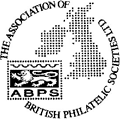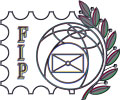|
Introduction
It is now essential in national and international
competition that each exhibit, no matter what
class, should have an introductory page which
explains what the exhibit is trying to show. The
Hampshire Philatelic Federation has adopted this
change and therefore requires an introductory page
for all classes. The introductory page (also called
the Title Page) is intended to give structure,
scope and content to the viewer and should include
something pictorial (e.g. a map, proof, or cover).
The introductory page is usually the first sheet of
the 16 or 32 sheet exhibit.
Traditional Class
The collecting of postage stamps, proofs, essays,
colour trials and such items, and the specific
study of stamps mint or used and including usage.
Entries may include stamps of any countries, may
cover any period of time and be specialised or non
specialised.
Aerophilatelic Class
This class covers the study of stamps, stickers,
envelopes and covers relating to any form of
airmail transmission of mail, whether official or
unofficial. Entries may contain items commemorating
aerial meetings and events. Relevant
advertisements, photographs, notices, press
cuttings, maps, leaflets and so on may be included
as are absolutely necessary, as may autographed
letters relating to aero postal history. Entries
which consist solely of airmail stamps will also be
judged in this class.
Postal History Class
The study of postal services, routes, rates, postal
markings of any form related to the carriage of
mails. (This category does not include mint or
unused stamps or stationery). Postal history
entries should consist of material ranging from pre
adhesive entires and letters, to stamped or
stampless covers of the present day. Postmarks and
cancellations, whether on loose stamps, pieces, or
covers, may be included together with a limited
quantity of appropriate collateral or associated
items, provided that the principal part of the
entry is material conveyed by post.
Cinderella Class May include local stamps, telegraph stamps, railway stamps, revenues/fiscals, and forgeries, bogus and phantom issues. Christmas, Red Cross, TB and other charity seals, registration labels, advertisement and exhibition labels etc. However, things such as trade, cigarette and telephone cards (unless the image of a stamp is incorporated in the design), matchbox or cheese labels, aerial propaganda leaflets, and other forms of ephemera like emergency money are not considered as Cinderella items for this purpose. Postal Stationery Class
The study of all items of stationery issued by
postal authorities including postcards,
lettercards, envelopes, registered envelopes,
newspaper wrappers, aerograms, parcel cards and
similar items.
Thematic Class
A collection of all the above aspects, combined
into a common theme such as "The meaning of
Christmas", "The world of Flowers" and similar
approaches. Sometimes referred to as Topical
collecting, but different from Subject collecting
(for example "Flowers on stamps"). The range of
themes is limited only by the imagination and
inventiveness of the collector and exhibitor. This
class employs a wide range of philatelic skills.
Entries based on a theme are developed according to
a logical plan and by the use of appropriate
philatelic material. The entry should have an
introductory page which contains a plan of the
entire exhibit, and this plan must be fully
consistent with the title of the entry. The plan
should define the structure of the entry and the
division of it into parts: it should cover all
aspects of the chosen theme. The plan has to be
laid out in accordance with the demands of the
theme itself, and should not be merely a
classification by issue date and/or country of
issue. Each item selected for the entry must be
strictly related to the chosen theme, and this
relationship has to be of a postal nature and not
consist of privately produced items. Entrants are
advised to ensure that they include only genuine
postage stamps, and omit those items that are
regarded as being of a dubious or undesirable
nature. Philatelic items (e.g. stamps and
documents) represent the essential elements of a
thematic entry. Non philatelic items should not
normally be included, and if maps, drawings or
photographs are felt to be essential to the
development of the theme, they should be kept to an
absolute minimum.
Revenues Class
For the purposes of this competition, these are
defined as material not recognised for the
international transmission of mail but accepted as
being issued locally or generally for the
transmission of messages or packages (e.g. local,
railway or telegraph), or for the collection of non
postal revenue.
Open Philately This class gives an exhibitor complete freedom to present an exhibit on any subject using up to 50% of non-philatelic items. The non-philatelic material must not be thicker than 5 mm so as to be able to fit into standard exhibition frames. Open Philately definition has tried to keep rules to a minimum to make exhibiting more accessible and to allow for more creativity. Those exhibitors who have previously entered HAMPEX with 'Social Class' exhibits should note that HAMPEX does not support such a class and should consider entering an exhibit that follows these Open Philately guidelines. Guidelines for Open Philately Exhibits The Open Philately Exhibit Open Philately Judging ConsiderationsTitle, Idea, and Creativity Treatment Material Presentation Picture Postcard Class For competition purposes a Picture Postcard must have an illustration and may be Used (must show that they have been through a postal service) or Unused (must have printed text or printed address lines, for example a postage area, which shows that the card is meant to be posted without an envelope). A Picture Postcard exhibit must have a title and plan on the introductory page. The plan must show the intention and the structure of the exhibit. The title as well as the main and sub sections of the exhibit must show the structure and logical development through the exhibit and demonstrate personal creativity, knowledge, and research. The title must mirror the content of the exhibit in the best possible way. The treatment of the exhibit must be according to the title and plan. Each Picture Post card must have a connection with the chosen topic. Research is a pre-requisite for knowledge of the topic and the Picture Postcards, and this is demonstrated in a brief text in connection with each Picture Postcard. Guidance on how Picture Postcard exhibits are to be judged is included on this ABPS guidance page. [Understanding what the judges are looking for is half way towards creating a powerful exhibit - in all classes.] References FIP - Special Regulations for the Evaluation of Open Class Exhibits. The basis of these Special Regulations is the General Regulations of the FIP for the Evaluation of Competitive Exhibits at FIP Exhibitions (GREV). ABPS: Exhibiting and Rules Click here to contact the HAMPEX Organising Committee members. For guidance on International Competition and Exhibiting review the General Regulations of the FIP for the Evaluation of Competitive Exhibits at FIP Exhibitions on the FIP website below. July 2020 |


